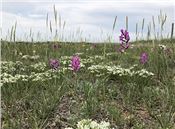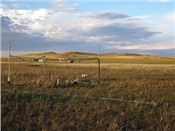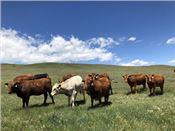Soil Disturbance Reduces Resilience Of Rangelands To Climate Change
BELTSVILLE, MARYLAND
USDA's Agricultural Research Service (ARS) scientists and collaborators from the Hawkesbury Institute for the Environment tested how soil disturbance influences the response of U.S. Great Plains rangeland to climate change. The results showed that disturbance and subsequent plant invasion are key factors to consider when predicting the impact of climate change on these ecosystems.
Rangelands, the grasslands that we depend on for livestock production, biological diversity, and many other ecosystem services, are being altered by climate change. While researchers have studied these changes, including the influence of rising carbon dioxide and warmer temperatures, the focus has historically been on intact or relatively undisturbed ecosystems.
The study published today in Global Change Biology shows that effects of increased carbon dioxide and warming differ significantly in disturbed rangeland compared to intact native rangeland.
"We know that disturbing rangeland causes various problems, including plant invasion and loss of plant diversity," said Dana Blumenthal, a research ecologist and lead author with the ARS Rangeland Resources & Systems Research. "What this new study demonstrates is that rising carbon dioxide makes it more difficult to recover from that type of change."
The study, conducted in mixed-grass prairie in southeastern Wyoming, used circular plots of intact native prairie or disturbed prairie.
Seeds of native and invasive plants were added to disturbed prairie plots to represent colonization of the disturbed area by new species.
Over a five-year period, scientists measured plant production, plant diversity, and soil carbon levels after plots were continually exposed to high levels of carbon dioxide and warm temperatures.
The main result was that elevated carbon dioxide more than doubled plant production in the disturbed prairie, primarily due to the rapid growth of diffuse knapweed (Centaurea diffusa), an unpalatable invasive species causing problems in U.S. rangelands. This large increase in production then led to a decline in plant diversity. In contrast, elevated carbon dioxide increased plant production by only 18 percent in intact prairie, while increasing plant diversity. The scientists also observed greater carbon loss in the soil of the disturbed prairie when exposed to warmer temperatures.
"We saw that these disturbances, combined with plant invasion, greatly reduce the resilience of mixed-grass prairie to climate change. That tells us that disturbance is a key factor that should be accounted for when predicting effects of future climatic conditions in these ecosystems," said Blumenthal.
The research is part of a series of studies (Nature 2011; Global Change Biology 2016; Ecology Letters 2016) on the influence of climatic conditions and plant invasion on native and disturbed rangeland ecosystems. ∆

Plant diversity on intact prairie.

Each experimental circular plot was randomly divided into intact prairie and disturbed prairie and treated
with different variations of atmospheric carbon dioxide and temperature.
Photos by Julie Kray

Cattle grazing in a northern mixed-grass prairie near Cheyenne, Wyoming, where the experiment was completed.